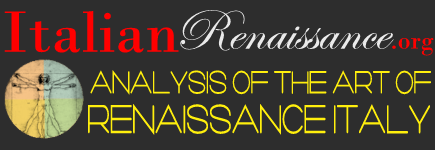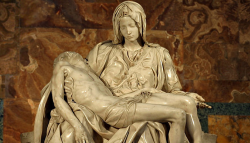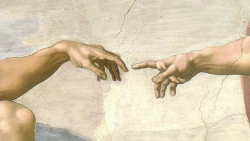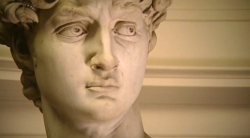From Giorgio Vasari, Lives of the Most Excellent Italian Painters, Sculptors, and Architects
Giovanni Pisano (c. 1250 – c. 1315)
Niccola had, among others, a son called Giovanni, who, because he ever followed his father and applied himself under his teaching to sculpture and to architecture, in a few years became not only equal to his father but in some ways superior; wherefore Niccola, being now old, retired to Pisa, and living there quietly left the management of[Pg 36] everything to his son. Pope Urban IV having died at that time in Perugia, a summons was sent to Giovanni, who, having gone there, made a tomb of marble for that Pontiff, which, together with that of Pope Martin IV, was afterwards thrown to the ground when the people of Perugia enlarged their Vescovado, in a manner that there are seen only a few relics of it scattered throughout the church. And the people of Perugia, at the same time, having brought a very great body of water through leaden pipes from the hill of Pacciano, two miles distant from the city, by means of the genius and industry of a friar of the Silvestrines, it was given to Giovanni Pisano to make all the ornaments of the fountain, both in bronze and in marble; wherefore he put his hand thereto and made three tiers of basins, two of marble and one of bronze. The first is placed above twelve rows of steps, each with twelve sides; the other on some columns that stand on the lowest level of the first basin—that is, in the middle; and the third, which is of bronze, rests on three figures, and has in the middle certain griffins, also of bronze, that pour water on every side; and because it appeared to Giovanni that he had done very well in this work, he put on it his name. About the year 1560, the arches and the conduits of this fountain (which cost 160,000 ducats of gold) having become in great part spoilt and ruined, Vincenzio Danti, a sculptor of Perugia, without rebuilding the arches, which would have been a thing of the greatest cost, very ingeniously reconducted the water to the fountain in the way that it was before, with no small credit to himself.
This work finished, Giovanni, desiring to see again his old and ailing father, departed from Perugia in order to return to Pisa; but, passing through Florence, he was forced to stay, to the end that he might apply himself, together with others, to the work of the Mills on the Arno, which were being made at S. Gregorio near the Piazza de’ Mozzi. But finally, having had news that his father Niccola was dead, he went to Pisa, where, by reason of his worth, he was received by the whole city with great honour, every man rejoicing that after the loss of Niccola there still remained Giovanni, as heir both of his talents and of his wealth. And the occasion having come of making proof of him, their opinion was in no way disappointed, because, there being certain things to do in the small but most ornate Church of S. Maria della Spina, they were given to Giovanni to do, and he, putting his hand thereunto, with the help of some of his boys brought many ornaments in that oratory to that perfection that is seen to-day; which work, in so far as we can judge, must have been held miraculous in those times, and all the more that he made in one figure the portrait of Niccola from nature, as best he knew.
Seeing this, the Pisans, who long before had had the idea and the wish to make a place of burial for all the inhabitants of the city, both noble and plebeian, either in order not to fill the Duomo with graves or for some other reason, caused Giovanni to make the edifice of the Campo Santo, which is on the Piazza del Duomo, towards the walls; wherefore he, with good design and with much judgment, made it in that manner and with those ornaments of marble and of that size which are to be seen; and because there was no consideration of expense, the roof was made of lead. And outside the principal door there are seen these words carved in marble:
A.D. MCCLXXVIII. TEMPORE DOMINI FREDERIGI ARCHIEPISCOPI PISANI, ET
DOMINI TARLATI POTESTATIS, OPERARIO ORLANDO SARDELLA, JOHANNE
MAGISTRO ÆDIFICANTE.
This work finished, in the same year, 1283, Giovanni went to Naples, where, for King Charles, he made the Castel Nuovo of Naples; and in order to have room and to make it stronger, he was forced to pull down many houses and churches, and in particular a convent of Friars of S. Francis, which was afterwards rebuilt no little larger and more magnificent than it was before, far from the castle and under the title of S. Maria della Nuova. These buildings being begun and considerably advanced, Giovanni departed from Naples, in order to return to Tuscany; but arriving at Siena, without being allowed to go on farther he was caused to make the model of the façade of the Duomo of that city, and afterwards the said façade was made very rich and magnificent from this model. Next, in the year 1286, when the Vesco[Pg 38]vado of Arezzo was building with the design of Margaritone, architect of Arezzo, Giovanni was brought from Siena to Arezzo by Guglielmino Ubertini, Bishop of that city, where he made in marble the panel of the high-altar, all filled with carvings of figures, of foliage, and other ornaments, distributing throughout the whole work certain things in delicate mosaic, and enamels laid on plates of silver, let into the marble with much diligence. In the middle is a Madonna with the Child in her arms, and on one side S. Gregory the Pope, whose face is the portrait from life of Pope Honorius IV; and on the other side is S. Donatus, Bishop and Protector of that city, whose body, with those of S. Antilla and of other Saints, is laid under that same altar. And because the said altar stands out by itself, round it and on the sides there are small scenes in low-relief from the life of S. Donatus, and the crown of the whole work are certain tabernacles full of marble figures in the round, wrought with much subtlety. On the breast of the said Madonna is a bezel-shaped setting of gold, wherein, so it is said, were jewels of much value, which have been carried away in the wars, so it is thought, by soldiers, who have no respect, very often, even for the most holy Sacrament, together with some little figures in the round that were on the top of and around that work; on which the Aretines spent altogether, according to what is found in certain records, 30,000 florins of gold. Nor does this seem anything great, seeing that at that time it was something as precious and rare as it could well be; wherefore Frederick Barbarossa, returning from Rome, where he had been crowned, and passing through Arezzo, many years after it had been made, praised it, nay, admired it infinitely; and in truth with great reason, seeing that, besides everything else, the joinings of this work, made of innumerable pieces, are cemented and put together so well that the whole work is easily judged, by anyone who has not much practice in the matters of the art, to be all of one piece. In the same church Giovanni made the Chapel of the Ubertini, a most noble family, and lords of castles, as they still are to-day and were formerly even more; with many ornaments of marble, which to-day have been covered over with other ornaments of grey-stone, many and fine, which were set up in that place with the design of Giorgio Vasari in the year 1535, for the supporting of an organ of extraordinary excellence and beauty that stands thereon.
Giovanni Pisano likewise made the design of the Church of S. Maria de’ Servi, which to-day has been destroyed, together with many palaces of the most noble families of the city, for the reasons mentioned above. I will not forbear to say that Giovanni made use, in working on the said marble altar, of certain Germans who had apprenticed themselves to him rather for learning than for gain; and under his teaching they became such that, having gone after this work to Rome, they served Boniface VIII in many works of sculpture for S. Pietro, and in architecture when he made Cività Castellana. Besides this, they were sent by the same man to S. Maria in Orvieto, where, for its façade, they made many figures in marble which were passing good for those times. But among others who assisted Giovanni in the work of the Vescovado in Arezzo, Agostino and Agnolo, sculptors and architects of Siena, surpassed in time all the others, as will be told in the proper place. But returning to Giovanni; having departed from Orvieto, he came to Florence, in order to see the fabric of S. Maria del Fiore that Arnolfo was making, and likewise to see Giotto, of whom he had heard great things spoken abroad; and no sooner had he arrived in Florence than he was charged by the Wardens of the said fabric of S. Maria del Fiore to make the Madonna which is over that door of the church that leads to the Canon’s house, between two little angels; which work was then much praised. Next, he made the little baptismal font of S. Giovanni, wherein are certain scenes in half-relief from the life of that Saint. Having then gone to Bologna, he directed the building of the principal chapel of the Church of S. Domenico, wherein he was charged by Bishop Teodorigo Borgognoni of Lucca, a friar of that Order, to make an altar of marble; and in the same place he afterwards made, in the year 1298, the marble panel wherein are the Madonna and eight other figures, reasonably good.
In the year 1300, Niccola da Prato, Cardinal Legate of the Pope, being in Florence in order to accommodate the dissensions of the Florentines, caused him to make a convent for nuns in Prato, which is called[Pg 40] S. Niccola from his name, and to restore in the same territory the Convent of S. Domenico, and so too that of Pistoia; in both the one and the other of which there are still seen the arms of the said Cardinal. And because the people of Pistoia held in veneration the name of Niccola, father of Giovanni, by reason of that which he had wrought in that city with his talent, they caused Giovanni himself to make a pulpit of marble for the Church of S. Andrea, like to the one which he had made in the Duomo of Siena; and this he did in order to compete with one which had been made a little before in the Church of S. Giovanni Evangelista by a German, who was therefore much praised. Giovanni, then, delivered his finished in four years, having divided this work into five scenes from the life of Jesus Christ, and having made therein, besides this, a Universal Judgment, with the greatest diligence that he knew, in order to equal or perchance to surpass the one of Orvieto, then so greatly renowned. And round the said pulpit, on the architrave, over some columns that support it, thinking (as was the truth, according to the knowledge of that age) that he had done a great and beautiful work, he carved these verses:
HOC OPUS SCULPSIT JOANNES, QUI RES NON EGIT INANES,
NICOLI NATUS …… MELIORA BEATUS, QUEM GENUIT PISA, DOCTUM SUPER OMNIA VISA.
At the same time Giovanni made the holy-water font, in marble, of the Church of S. Giovanni Evangelista in the same city, with three figures that support it—Temperance, Prudence, and Justice; which work, by reason of its having then been held very beautiful, was placed in the centre of that church as something remarkable. And before he departed from Pistoia, although the work had not up to then been begun, he made the model of the Campanile of S. Jacopo, the principal church of that city; on which campanile, which is on the square of the said S. Jacopo and beside the church, there is this date: A.D. 1301.
Afterwards, Pope Benedict IX having died in Perugia, a summons was sent to Giovanni, who, having gone to Perugia, made a tomb of marble for that Pontiff in the old Church of S. Domenico, belonging to the Preaching Friars; the Pope, portrayed from nature and robed in his pontifical habits, is lying at full length on the bier, with two angels, one on either side, that are holding up a curtain, and above there is a Madonna with two saints in relief, one on either side of her; and many other ornaments are carved round that tomb. In like manner, in the new church of the said Preaching Friars he made the tomb of Messer Niccolò Guidalotti of Perugia, Bishop of Recanati, who was founder of the Sapienza Nuova of Perugia. In this new church, which had been founded before this by others, he executed the central nave, which was founded by him with much better method than the remainder of the church had been; for on one side it leans and threatens to fall down, by reason of having been badly founded. And in truth, he who puts his hand to building and to doing anything of importance should ever take counsel, not from him who knows little but from the best, in order not to have to repent after the act, with loss and shame, that where he most needed good counsel he took the bad.
Giovanni, having dispatched his business in Perugia, wished to go to Rome, in order to learn from those few ancient things that were to be seen there, even as his father had done; but being hindered by good reasons, this his desire did not take effect, and the rather as he heard that the Court had just gone to Avignon. Returning, then, to Pisa, Nello di Giovanni Falconi, Warden, caused him to make the great pulpit of the Duomo, which is on the right hand going towards the high-altar, attached to the choir; and having made a beginning with this and with many figures in the round, three braccia high, that were to serve for it, little by little he brought them to that form that is seen to-day, placing the pulpit partly on the said figures and partly on some columns sustained by lions; and on the sides he made some scenes from the life of Christ. It is a pity, truly, that so great cost, so great diligence, and so great labour should not have been accompanied by good design and should be wanting in perfection and in excellence of invention, grace, and manner, such as any work of our own times would show, even if made with much less cost and labour. None the less, it must have caused no small marvel to the men of those times, used to seeing only the rudest works.[Pg 42] This work was finished in the year 1320, as appears in certain verses that are round the said pulpit, which run thus:
LAUDO DEUM VERUM, PER QUEM SUNT OPTIMA RERUM,
QUI DEDIT HAS PURAS HOMINEM FORMARE FIGURAS;
HOC OPUS HIS ANNIS DOMINI SCULPSERE JOHANNIS
ARTE MANUS SOLE QUONDAM, NATIQUE NICOLE,
CURSIS VENTENIS TERCENTUM MILLEQUE PLENIS;
with other thirteen verses, which are not written, in order not to weary the reader, and because these are enough not only to bear witness that the said pulpit is by the hand of Giovanni, but also that the men of these times were in all things made thus. A Madonna of marble, also, that is seen between S. John the Baptist and another Saint, over the principal door of the Duomo, is by the hand of Giovanni; and he who is at the feet of the Madonna, on his knees, is said to be Piero Gambacorti, Warden of Works. However this may be, on the base whereon stands the image of Our Lady there are carved these words:
SUB PETRI CURA HÆC PIA FUIT SCULPTA FIGURA,
NICOLI NATO SCULPTORE JOHANNE VOCATO.
In like manner, over the side door that is opposite the campanile, there is a Madonna of marble by the hand of Giovanni, having on one side a woman kneeling with two babies, representing Pisa, and on the other the Emperor Henry. On the base whereon stands the Madonna are these words:
AVE GRATIA PLENA, DOMINUS TECUM;
and beside them:
NOBILIS ARTE MANUS SCULPSIT JOHANNES PISANUS
SCULPSIT SUB BURGUNDIO TADI BENIGNO….
And round the base of Pisa:
VIRGINIS ANCILLA SUM PISA QUIETA SUB ILLA.
And round the base of Henry:
IMPERAT HENRICUS QUI CHRISTO FERTUR AMICUS.
MADONNA AND CHILD
In the old Pieve of the territory of Prato, under the altar of the principal chapel, there had been kept for many years the Girdle of Our Lady, which Michele da Prato, returning from the Holy Land, had brought to his country in the year 1141 and consigned to Uberto, Provost of that church, who placed it where it has been said, and where it had been ever held in great veneration; and in the year 1312 an attempt was made to steal it by a man of Prato, a fellow of the basest sort, and as it were, another Ser Ciappelletto; but having been discovered, he was put to death for sacrilege by the hand of justice. Moved by this, the people of Prato determined to make a strong and suitable resting-place, in order to hold the said Girdle more securely; wherefore, having summoned Giovanni, who was now old, they made with his counsel, in the greater church, the chapel wherein there is now preserved the said Girdle of Our Lady. And next, with the same man’s design, they made the said church much larger than it was before, and encrusted it without with white and black marbles, and likewise the campanile, as may be seen. Finally, being now very old, Giovanni died in the year 1320, after having made, besides those that have been mentioned, many other works in sculpture and in architecture. And in truth there is much owed to him and to his father Niccola, seeing that, in times void of all goodness of design, they gave in so great darkness no small light to the matters of these arts, wherein they were, for that age, truly excellent. Giovanni was buried in the Campo Santo, with great honour, in the same grave wherein had been laid Niccola, his father. There were as disciples of Giovanni many who flourished after him, but in particular Lino, sculptor and architect of Siena, who made in the Duomo of Pisa the chapel all adorned with marble wherein is the body of S. Ranieri, and likewise the baptismal font that is in the said Duomo, with his name.
Nor let anyone marvel that Niccola and Giovanni did so many works, because, not to mention that they lived very long, being the first masters that were in Europe at that time, there was nothing done of any importance in which they did not have a hand, as can be seen in many inscriptions besides those that have been mentioned. And seeing that,[Pg 44] while touching on these two sculptors and architects, there has been something said of matters in Pisa, I will not forbear to say that on the top of the steps in front of the new hospital, round the base that supports a lion and the vase that rests on the porphyry column, are these words:
THIS IS THE MEASURE WHICH THE EMPEROR CÆSAR GAVE TO PISA, WHEREWITH THERE WAS MEASURED THE TRIBUTE THAT WAS PAID TO HIM; WHICH HAS BEEN SET UP OVER THIS COLUMN AND LION, IN THE TIME OF GIOVANNI ROSSO, WARDEN OF THE WORKS OF S. MARIA MAGGIORE IN PISA, A.D. MCCCXIII., IN THE SECOND INDICTION, IN MARCH.



